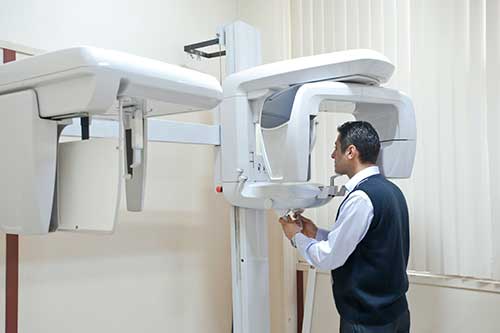Panoramic X-rays
Kent Family Dentistry

A very small dosage of ionizing radiation is used in panoramic dental x-rays to produce an image that includes the whole mouth. It can be used to plan treatment for dentures, braces, extractions, and implants and is frequently carried out by dentists and oral surgeons in routine practice.
There is minimal to no specific preparation needed for this exam. If you think you could be pregnant, let your doctor know. Take off any jewelry, glasses, or other metal objects that could obstruct the x-ray pictures. To shield your body from radiation exposure, you will be required to wear a lead apron.
What is Panoramic X-ray?
A two-dimensional (2-D) dental x-ray examination known as panoramic radiography, commonly known as a panoramic x-ray, captures the complete mouth in a single image, including the teeth, upper and lower jaws, surrounding structures, and tissues.
The jaw has a bent shape resembling a horseshoe. The curving structure, though, appears flat in the panoramic x-ray. Usually, it gives specifics about the teeth and bones.
Doctors use x-ray examinations to identify and treat medical disorders. To create images of the inside of the body, a small amount of ionizing radiation is exposed to you. The earliest and most used type of medical imaging is x-ray.
The film for a panoramic x-ray is contained inside the device, in contrast to a standard intraoral x-ray where the film/x-ray detector is inserted inside the mouth.
What are some common uses of the procedure?
In their routine practice, dentists and oral surgeons frequently perform a panoramic x-ray, which is a crucial diagnostic tool. It provides useful information concerning the maxillary sinuses, tooth location, and other bone anomalies since it covers a larger region than a traditional intraoral x-ray. This evaluation is also used to plan treatment for implants, braces, extractions, and complete and partial dentures.
A panoramic x-ray can also spot dental and health issues like:
- periodontal disease that is progressed
- bone cysts in the jaw
impacted teeth, especially wisdom teeth, and jaw tumors - jaw problems (also known as temporomandibular joint or TMJ disorders)
- sinusitis
What How should I prepare?
Not special preparation is required for a panoramic x-ray examination.
As a safety measure, you could be asked to put on a lead apron to shield the rest of your body from radiation exposure that could result from the panoramic x-ray beam scattering. Additionally, you could be requested to take off any jewelry from the area being scanned as well as your spectacles and any metal objects that might obstruct the x-ray images.
If there is even the slightest chance that a woman is pregnant, she should always let her dentist or oral surgeon know. In order to protect the fetus from radiation exposure, several imaging examinations are avoided during pregnancy. If an x-ray is required, safety measures will be taken to reduce the baby’s radiation exposure. For more information regarding x-rays and pregnancy, visit the Safety page.

